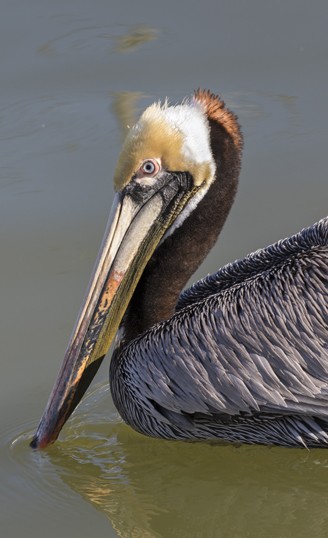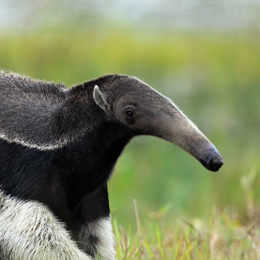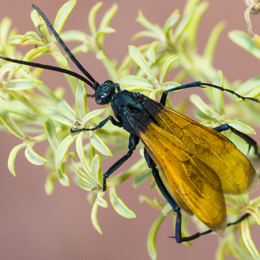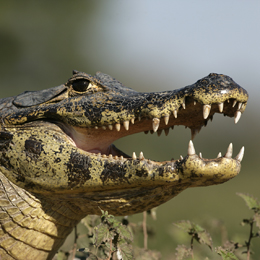Brown Pelican
The Brown Pelican is the most common seabird of America. Although it is the smallest pelican species, this bird has a large body with an average length of 121 cm (4 ft). Along with their large bill, Brown Pelicans have an enormous gular pouch which is an extendable skin sac located at the bottom of their throat, a prominent characteristic of all pelican species. This pouch is so large that it can hold over three gallons (11 liters) of water which is three times the capacity of their stomach.
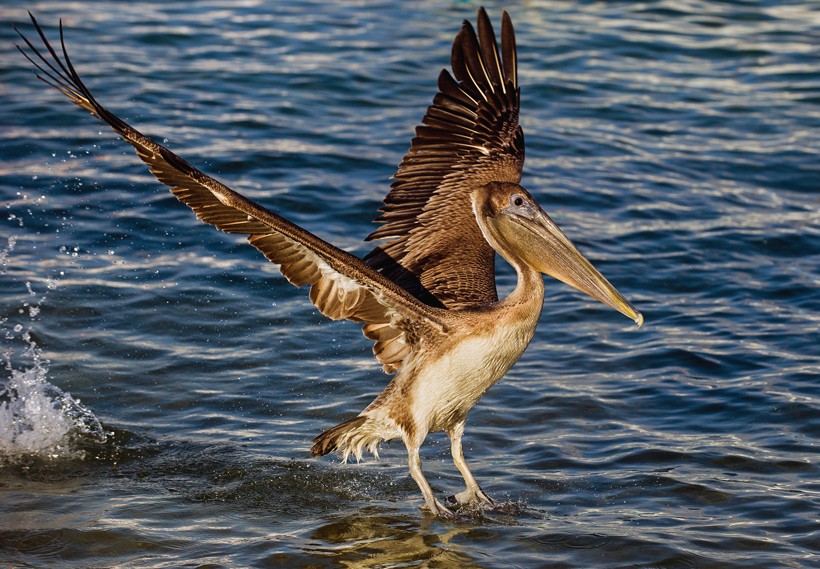
Brown Pelican landing on the water
?
Image credits: Kathy Kay/Shutterstock
The Brown Pelican has a wingspan that can be as long as 8.2 ft (250 cm). Males and females of this species look the same and cannot be identified easily if found alone. These birds are excellent hunters and can dive into the water from a height of 20 m (65 feet). Although they hardly fly at a high altitude, Brown Pelicans can attain a flying speed of 48 km/hr (30 miles/hr).
The lifespan of Brown Pelicans is quite long with the oldest recorded individual living up to the age of 43 years in the wild. However, the lifespan of this bird also varies depending on a number of factors that include the environmental condition and availability of food. As a result, the average lifespan of Brown Pelican is considered to be around 27 years.
Relative species and subspecies
The Pelecanus occidentalis shares its genus (Pelecanus) with seven other species of pelicans that includes the American White Pelican, Peruvian Pelican, Great White Pelican, Australian Pelican, Pink-backed Pelican, Dalmatian Pelican and the Spot-billed Pelican. Although the Brown Pelican is a large bird, in comparison to other pelicans found around the world it is actually the smallest existing pelican species.
Earlier, the Peruvian Pelican (Pelecanus thagus) was classified as a subspecies of the Brown Pelican (Pelecanus occidentalis) but further studies on these two birds led to the Peruvian Pelican being considered as a separate species. Although these two birds exhibit very similar plumage, the Peruvian Pelican is noticeably larger. The habitat of these two species can be seen overlapping in some marine areas of the South-American Pacific Coast. Moreover, the Brown Pelican also shares a close relationship with the American White Pelican which is not only much larger but also exhibits a white plumage unlike the Brown Pelicans.
Until recently, the Brown Pelican was considered a single species. However, depending on geographical range, five subspecies have been assigned.
- P. o. occidentalis, this subspecies can be found at the North and South American coast and in the West Indies, a region of the North Atlantic Ocean.
- P. o. carolinensis, this species inhabits the Atlantic coast from Carolina to Orinoco.
- P. o. californicus, the P.o. californicus can be found at the American Pacific coast from California to Northern Peru.
- P. o. murphy, the habitat of this species stretches from Colombia to Northern Peru.
- P. o. urinator, The P.o. urinator is found solely on the Galapagos Islands
Anatomy and Characteristics
Although it is the smallest pelican of the world, the Brown Pelican is a considerably large bird with a body length that can vary from 106 to 137 cm (42-54 inches). The adult Brown Pelican weighs about 2.75 to 5.5 kg (6.1 - 12.1 lb) and the length of its wingspan ranges from 1.8 to 2.5 m (6-8.2 ft). Similar to other species of pelicans, the Brown Pelican has a large bill (28 – 34.8 cm) with attached a big gular pouch at the bottom that helps in scooping up its marine prey.
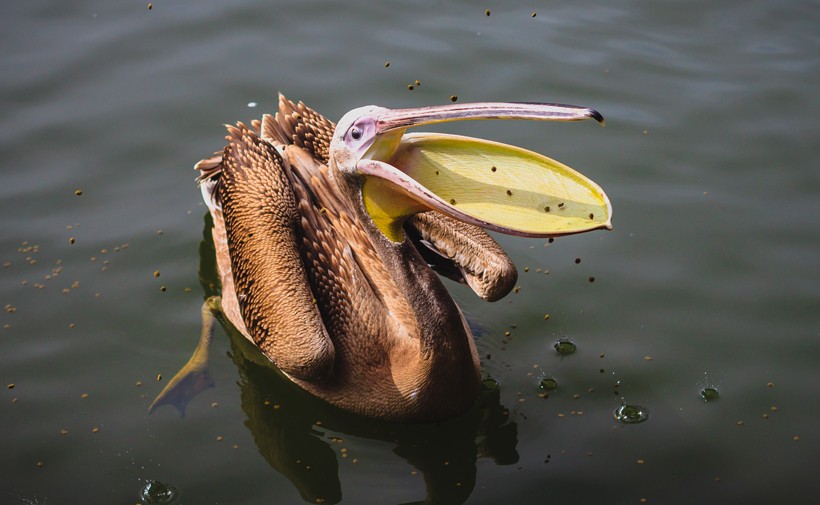
Brown Pelican catching food with its beak
?
Image credits: Natalija Berg/Shutterstock
The bill exudes a grayish hue most of the time, but during mating, the underside of the throat turns into bright red. The tail, back and rump have streaks of gray over the dark brown plumage which can sometimes be seen as a rusty hue.
A Blackish-brown color can be seen over their breast and belly while the legs and feet are covered with a black color. However, the underparts of the juveniles are mostly white with their neck being brownish-gray. The neck and head of the non-breeding adults remain white but during the breeding season the base of their fore-neck develop a yellow patch and the hind-necks become dark brown.
Habitat
Brown Pelicans live in warm and shallow coastal waters of the Atlantic and Pacific Oceans. In the US, they occur in large numbers in ten coastal states that include Louisiana, Florida, Texas, California, Alabama, Maryland, Virginia, Georgia and North and South Carolina. In Mexico, these birds can be seen along the coastal areas and offshore islands of the Gulf of Mexico and the Caribbean. The South American geographical range of Brown Pelicans includes the Caribbean coastal areas of the Galapagos Islands, Colombia, Venezuela and Aruba.
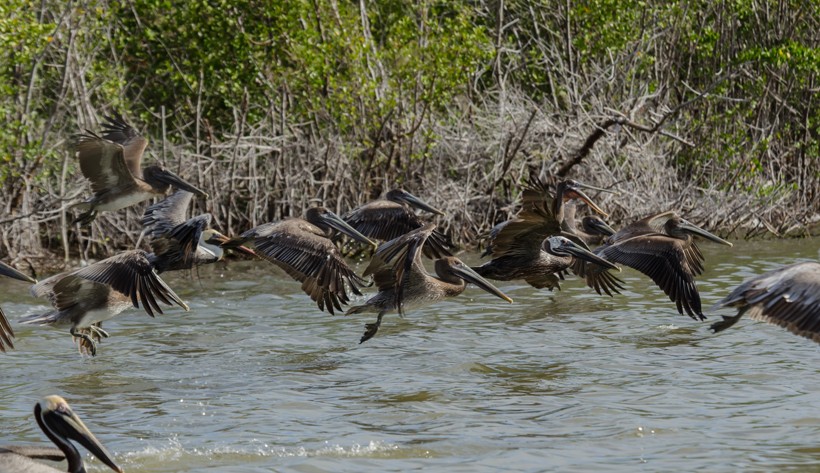
Brown Pelican flock flying
?
Image credits: GlenroyBlanchette/Shutterstock
Being strictly coastal, the Brown Pelicans live close to the shoreline that hardly exceeds the distance of 32 km (20 miles). During a non-breeding season, they mostly prefer the warm coastal waters and the marine estuaries. At night these birds roost offshore and loaf during the day or while foraging. The typical loaf and roost sites of Brown Pelicans include sandbars, jetties, pilings, mangrove islets, breakwaters and offshore rocks. For breeding, these pelicans often move to small islands that are predator-free. They are frequently seen breeding on natural estuarine islands, barrier islands and the dredge-spoil islands found along the Atlantic and the Gulf coasts. At the Pacific Coasts and Gulf of California, Brown Pelicans breed on dry and rocky islands and also occupy the mangroves on the mainland of Mexico. However, in the tropics, these birds can be seen in both coastal as well as inland mangroves including humid forests.
Diet, Hunting and Predation
Diet
Being a carnivorous bird, the diet of Brown Pelicans mostly includes small fish that are found in groups near the surface water. Some of their preferred fish include menhaden, anchovies, herring, mullet and sailfin mollies. Besides fish, this bird also eats invertebrates like prawns and they have been also seen scavenging on dead animals. Brown pelicans can occasionally steal prey from other seabirds.
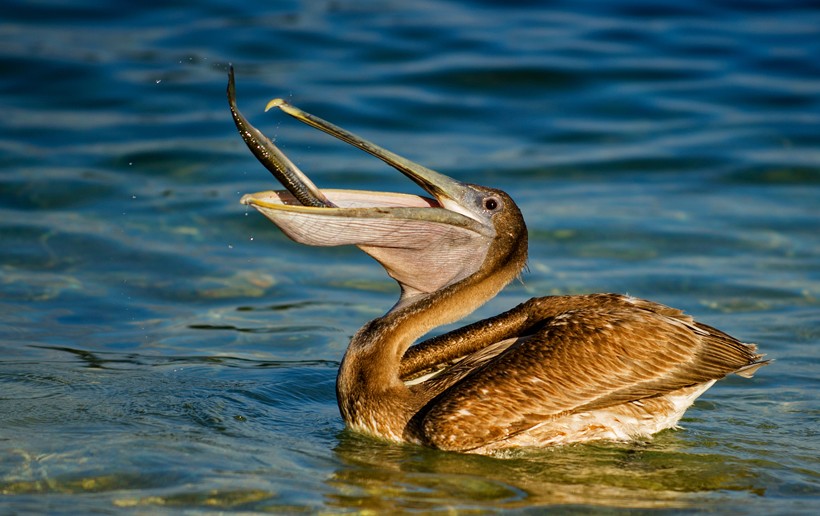
Brown Pelican eating a fish
?
Image credits: Kathy Kay/Shutterstock
Moreover, due to the presence of salt glands that helps in excreting excess salt in the body, Brown Pelicans can drink the salty sea water. Located nearby the eyes, these salt glands are about 3 cm long.
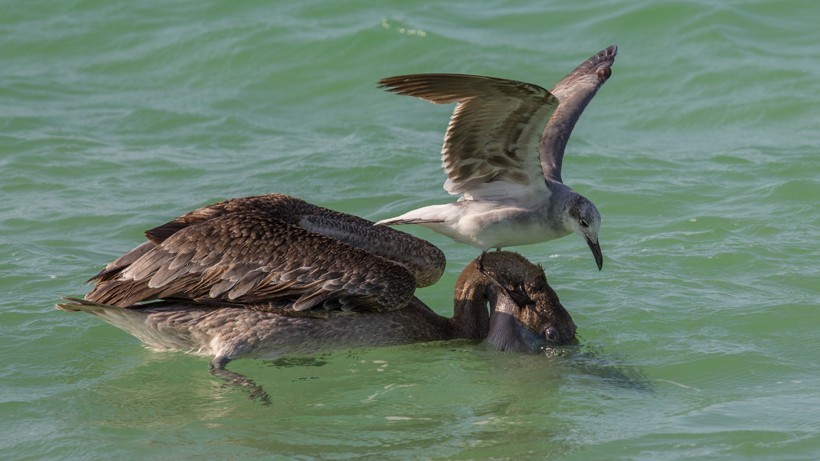
Gull attempting to steal a fish from a Brown Pelican
?
Image credits: Steffen Foerster/Shutterstock
Hunting
Brown Pelicans dive into the open water for foraging. Similar to the Kingfisher, they dive into water bill first from as high as 20 meters. With their astounding eyesight, they are able to spot their prey while in flight. As this pelican plunges into the water with the wings partially folded, it expands the throat pouch for trapping the fish by filling a large amount of water in it. In order to consume the prey, it drains the water through the sides of its large bill and swallows the fish by tipping back the head. However, this bird doesn’t carry any food in its throat pouch and uses it only for scooping up food while foraging. Brown Pelicans forage close to the shore above estuaries or shallow ocean waters which are hardly 20 km (12 miles) away from the shore. However, depending on the abundance of food Brown Pelicans may also forage in deeper waters.
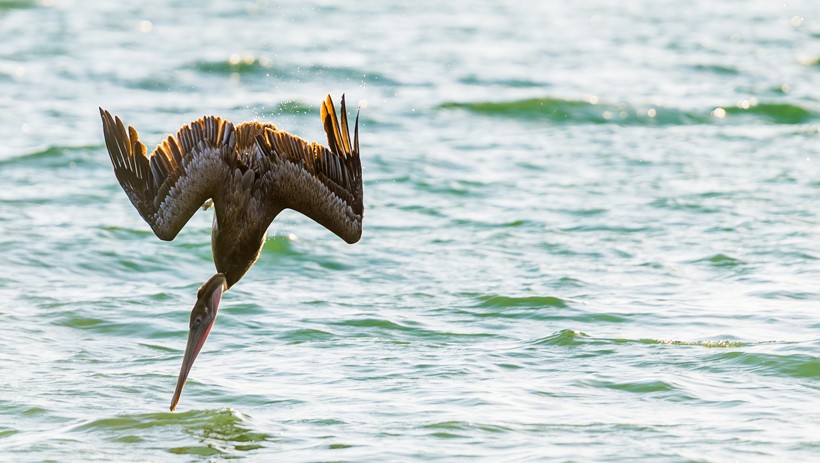
Brown Pelican diving into the water
?
Image credits: Arts Illustrated Studios/Shutterstock
Predation
Humans are the primary predators of Brown Pelicans as these birds are frequently hunted for their meat, eggs and feathers. Regarding their natural predators, the adult Brown Pelican rarely gets predated but occasionally might get attacked by sea lions and sharks while they float or forage in the open sea. Besides this, the hatchlings of this bird may get predated by Feral Cats, Skunks, Raccoons and Bobcats in case the Brown Pelicans build their nests around the habitat of these animals. Moreover, the eggs of Brown Pelicans may get eaten or destroyed by the fish crow and invasive species such as the red fire ants.
Reproduction and Life Cycle
Brown Pelicans nest in colonies on small islands or in mangroves. The nesting patterns of these birds are irregular and they are seasonally monogamous. Although nesting takes place all throughout the year among Brown Pelicans found in the tropical regions, it usually begins at the end of fall and lasts until June for the pelicans of non-tropical regions. The nesting is controlled by and dependent on various factors like molt length, food abundance, day length fluctuations, hurricane season and occurrence of freezing temperatures. In fact, local environment factors play a crucial role in determining their nesting seasons. They use the same nesting site all the year-round unless certain changes in their nesting habitat or food supply or any other kind of human disturbances induce an entire colony to relocate.
After selecting the nest site, the male performs a peculiar head-swaying or bowing movement for attracting a female. The female selects a male and both of them release a low call and engaged in building the nest. Nest building takes about 7-10 days during which the male bird presents the female with different nesting materials as part of their pair bonding and nest building ritual. The female lays the first egg after about three days upon completion of their nest.
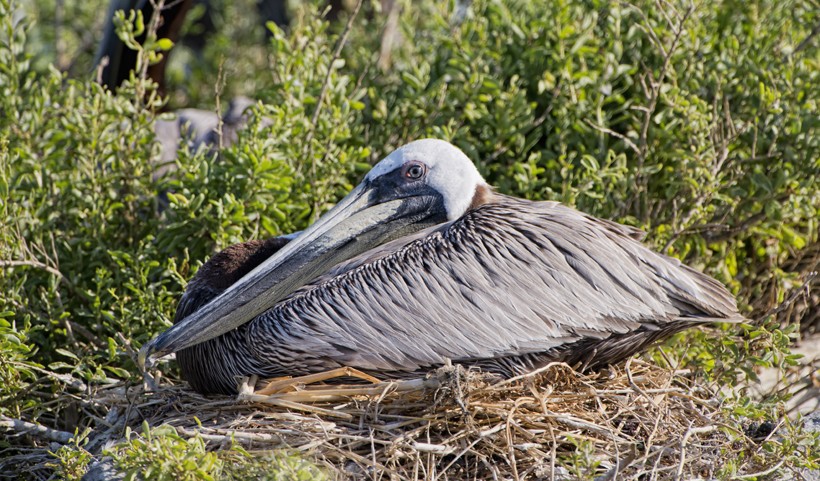
Brown Pelican on the nest at Queen Bess Island, Louisiana
?
Image credits: Bonnie Taylor Barry/Shutterstock
Brown Pelicans mostly build their nests on the ground but few of them also select the exposed treetops. For ground nests, they choose the areas with medium-density vegetation. On the other hand, ideal nest sites in trees are those spots that have enough nearby branches to allow them to land and take off conveniently. It is the female that builds the nest while the male brings her the building materials which is dependent on the available stuff in the direct environment. Ground nests can either be just a shallow depression on the ground, lined with grasses, sticks and leaves or a well-built structure made out of sticks, stems or seaweed.
Adult female Brown Pelicans lay an average of three eggs each season while the juvenile pelicans below 3 years of age lay only 2 eggs per season. The eggs have a chalky white coloration and a textured surface. These birds incubate their eggs underneath their webbed feet. Both parents participate equally in incubating the eggs which last for about 29 to 32 days. It has been found that only 70 % of the Brown Pelican’s eggs laid are able to hatch successfully. The chicks hatch by breaking open the eggshell with an egg-tooth present at the end of their beak. This egg tooth disappears within 7-10 days after hatching. The average weight of the hatchlings is 73.5 grams.
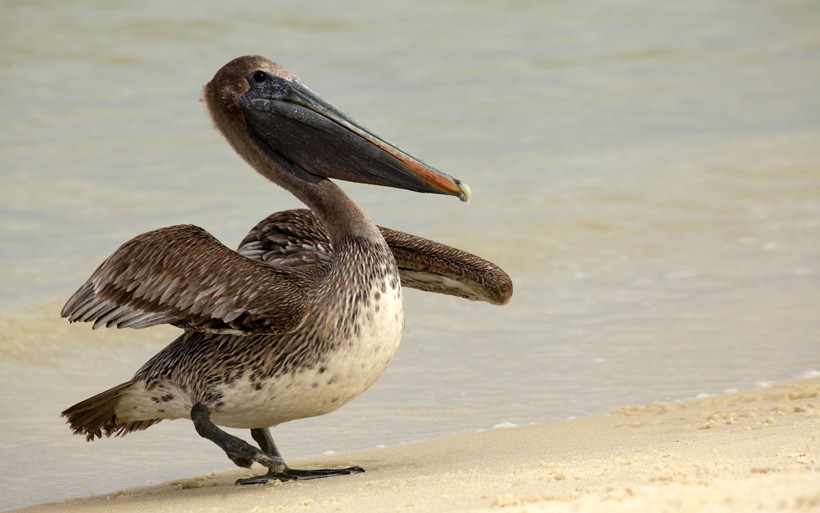
Immature Brown Pelican Landing on the white sand beach
?
Image credits: Steve Bower/Shutterstock
The skin of the newly hatched chicks is pinkish gray in color and covered by a fluff. By day 20, the chicks develop a white down while their legs and feet remain dull white. After about a month, the juvenile feathers of dark-gray or black appear over their entire body and retain this color until the age of 3, after which they develop their adult feathers. Before the chicks reach their fledging time, they are fed with regurgitated food by their parents. They fledge within 11 weeks and become completely independent after 3 months. Some individuals attain sexual maturity as early as 2 years of age while others after 4 years.
Behavior, Communication and Intelligence
Brown Pelicans are mostly diurnal by nature but a few individuals have been seen foraging during full moon nights. These birds are very gregarious and live in flocks which include both males and females. They sleep either standing on their feet or by resting on their belly and breast with their large bill tilted on one side and their head resting on the shoulder. Brown Pelicans possess a uropygial gland that secretes special oil which they rub all over their feathers with their bill in order to make them waterproof.
They also have air sacs in their bones and beneath their skin which makes them exceptionally buoyant in water but clumsy on land. Therefore, these pelicans can often be spotted floating on the sea water.
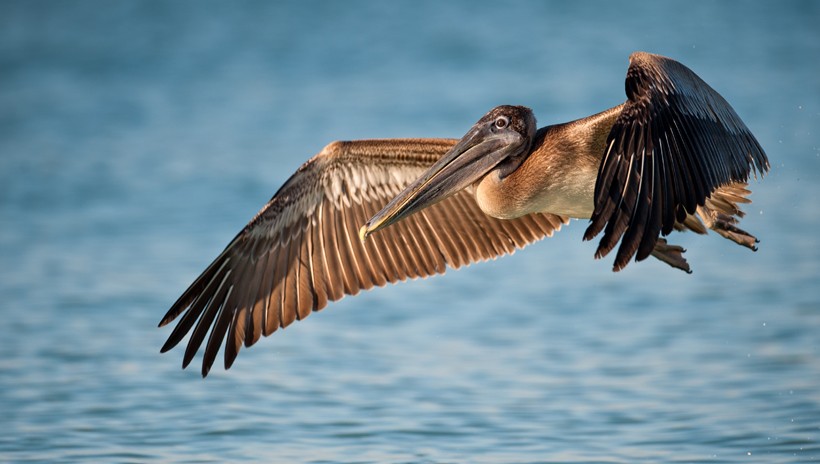
Brown Pelican in flight, Sanibel Island, Florida
?
Image credits: Nagel Photography/Shutterstock
Brown Pelicans generally fly in groups in level flight by holding back their heads over their shoulders and resting their bills onto their folded necks. They fly in a V-shape and at a very low altitude in order to remain close to the water surface. These birds have a tendency to become very territorial regarding their nesting site. They threaten other birds approaching their nesting area by swaying their head and making a loud “hrraa-hrraa” sound.
Brown Pelicans living in the northern ranges often migrate south during the fall and return in March and April. The migration is mainly induced by the cold weather which greatly affects the number of surface water prey. However, flocks of Brown Pelican living in the warmer climates do not migrate and stay within their original range of habitat all the time.
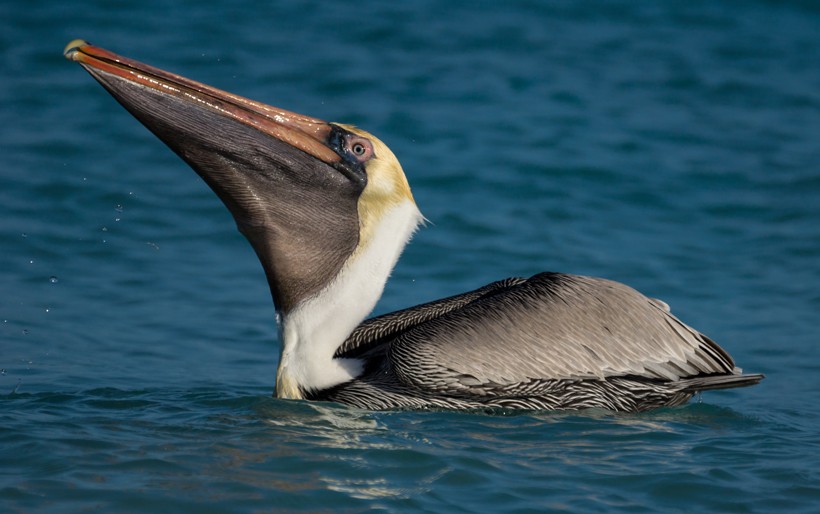
Brown Pelican with big pouch swimming
?
Image credits: FotoRequest/Shutterstock
These birds communicate by using visual cues, various calls and chemical signals. During mate selection, the adult Brown Pelican makes a low ‘hrraa-hrraa” call combined with head-swaying and bowing. Unhatched chicks, two days prior to hatching, make a peeping sound that can be heard from the eggs. After hatching, the chicks make a high-pitched and scratchy call for communicating with the parents.
Population and Conservation Status
Extensive use of DDT as a pesticide during the 1950’s and 1960’s in the US had a very negative effect on Brown Pelicans. It altered their physiology which caused that their eggshells became too thin to support the embryo until maturity. This resulted in a drastic decrease of their population by the end of the 1970’s which compelled the authorities to list this bird as an endangered species.
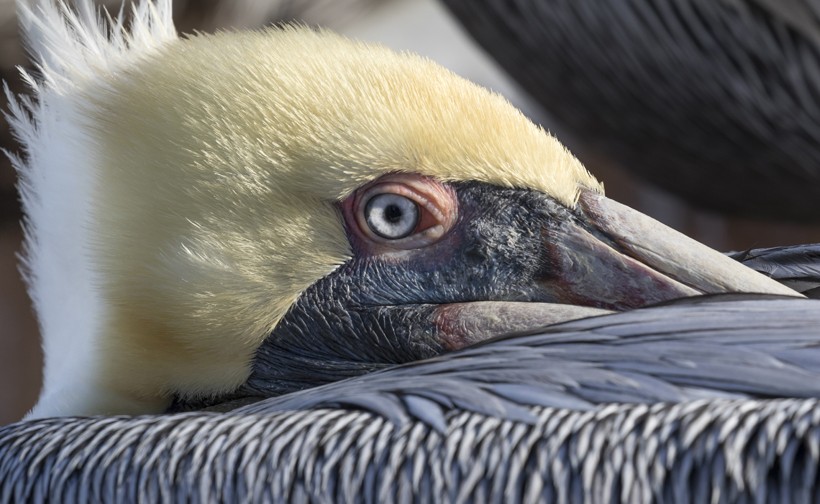
Brown Pelican closeup
?
Image credits: Ivan Kuzmin/Shutterstock
However, at present, this species of pelican has been listed as Least Concern on the IUCN Red List due to the steady recovery of their population over the last two decades. According to the latest estimation, the global population of Brown Pelican stands at about 650,000 individuals.
Cultural Depiction
Due to the abundance of Brown Pelicans in the coastal areas of the Americas, it is considered as a national bird by a number of countries and territories including Barbados, St. Kitts and Nevis, St. Martin and The Turks and Caicos Islands. It is also the state bird of Louisiana and can be seen as a mascot of the Tulane University. In fact, the Tulane and Louisiana State University use the image of Brown Pelicans on their seals. Besides this, the character of Nigel in the popular animated movie “Finding Nemo” is a Brown Pelican.
Funfacts
- The throat pouch of Brown Pelicans can hold about 3 gallons (11 liters) of water.
- The Brown Pelicans use their gular pouch as a net to ensnare their prey from water.
- As the Brown Pelican drains out enormous amounts of water from their gular pouch in order to swallow their prey, other seabirds often try to steal their food right from their mouth.
- The Brown pelicans is one of the three species of pelicans found in the coastal areas of Western Hemisphere.
- The Brown Pelican is considered as the only species of Pelicans that can feed by diving right into the open water.
- Although the Brown Pelican is quite large in appearance, it is actually the smallest species of pelican found around the world.
- This bird can fly at a speed of 48 km/hr (30 miles per hour).
- The Brown Pelican uses its gular pouch not only to collect fish but also to disperse heat during summer.
- The Brown Pelican can easily float on water thanks to the presence of air sacs underneath their skin and in their bones that makes them buoyant.
